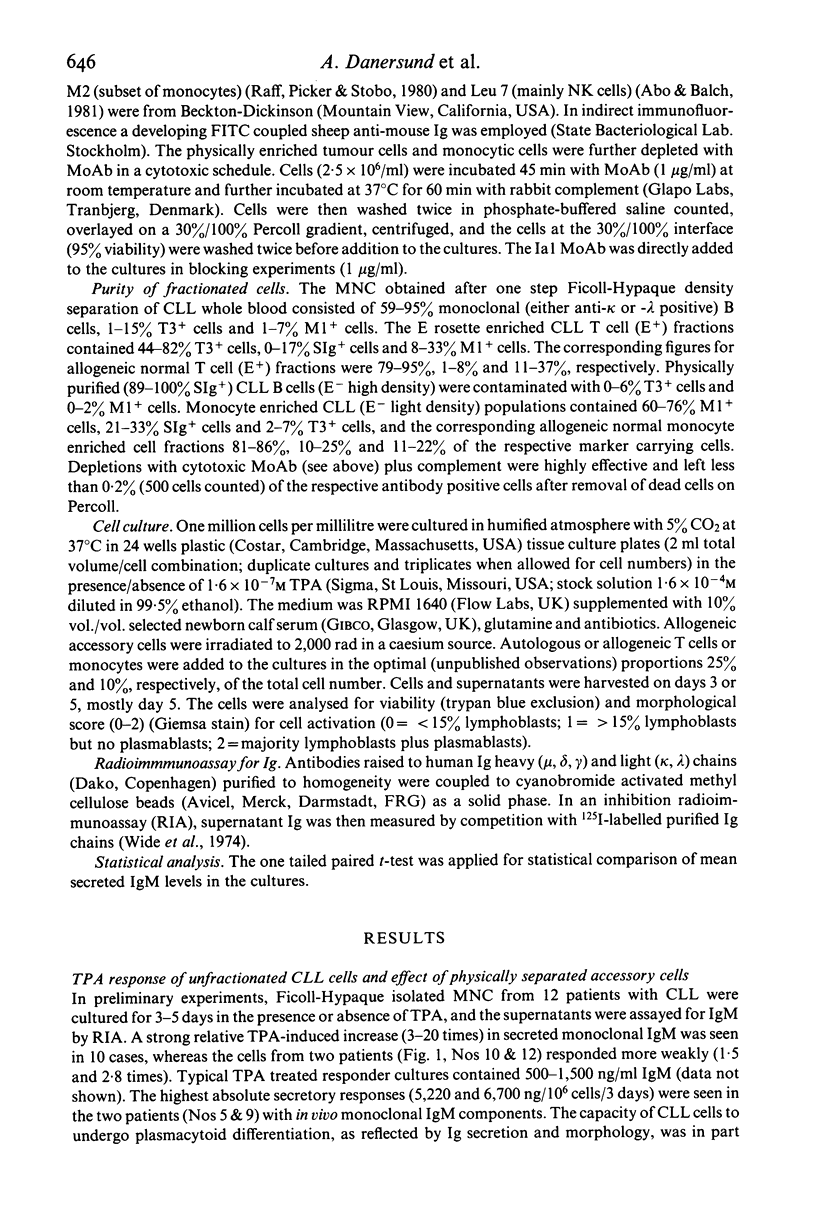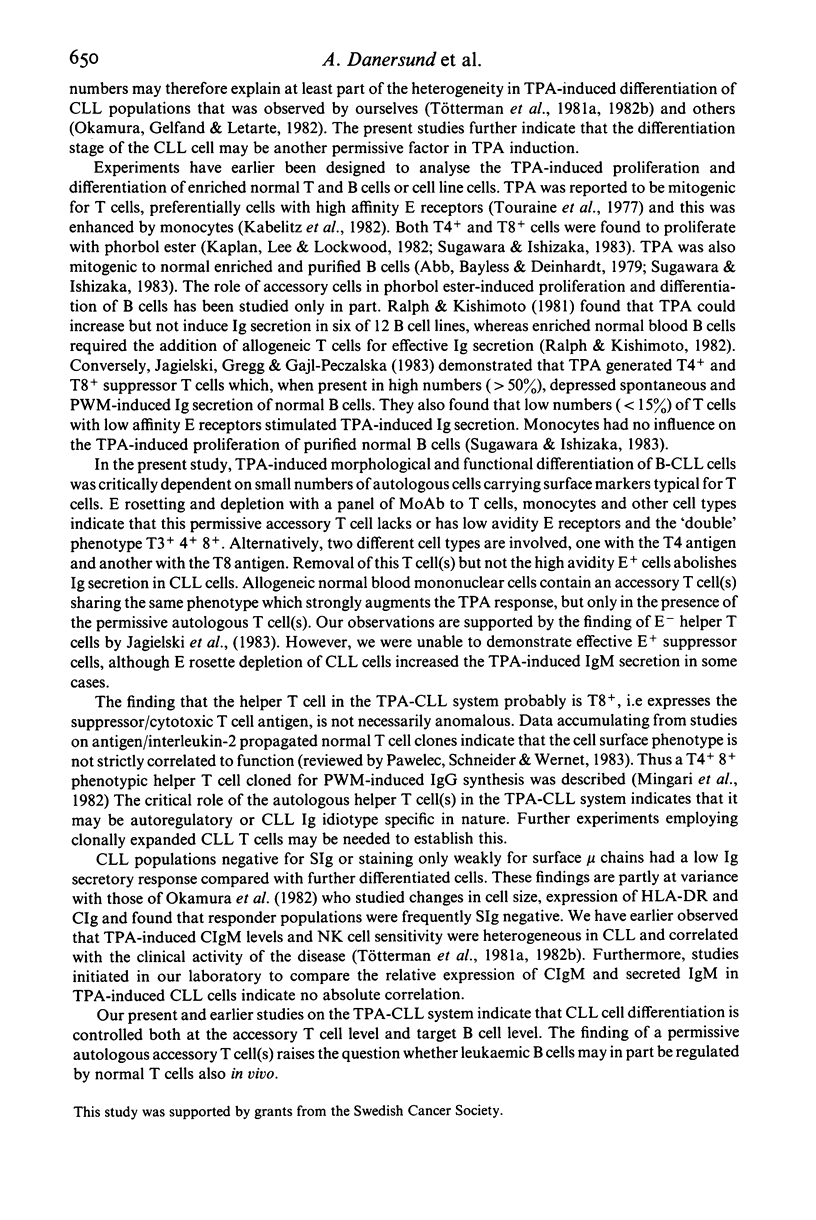Abstract
Phorbol ester (TPA) induction of chronic lymphocytic leukaemia (CLL) cells can be used as a model system for the study of human B cell differentiation. We have analysed the role of accessory cells and the correlation to target cell surface Ig phenotype in TPA-induced morphological and functional differentiation of 12 CLL populations. A more than three-fold increase in secreted IgM was seen in 10 of 12 cases, with the strongest responses in patients having monoclonal serum IgM. CLL populations negative for or having only weak surface mu chain expression were less inducible. The impact of autologous and allogeneic accessory cells on TPA induction was studied in cell enrichment/depletion experiments using both physical and cytotoxic antibody techniques. CLL cells physically depleted of autologous E+ and monocytic (light density fraction) cells still responded to TPA. This response could be enhanced by allogeneic E- light fraction cells. Further depletion of autologous accessory cells by treatment of the E- high density fraction CLL cells with a panel of monoclonal antibodies plus complement demonstrated the permissive role of one or two populations of autologous cells expressing low avidity E receptors and the T3, T4 and T8 antigens. Augmenting T cells of similar phenotype were found among allogeneic cells from normal individuals. Thus, TPA-induced IgM secretion in biopsy B-CLL cells is regulated by minute numbers of autologous helper T cells. Furthermore, the Ig secretory response of CLL populations seems to be correlated with the surface Ig the surface immunoglobulin phenotype of the leukaemic cells.
Full text
PDF








Selected References
These references are in PubMed. This may not be the complete list of references from this article.
- Abb J., Bayliss G. J., Deinhardt F. Lymphocyte activation by the tumor-promoting agent 12-O-tetradecanoylphorbol-13-acetate (TPA). J Immunol. 1979 May;122(5):1639–1642. [PubMed] [Google Scholar]
- Abo T., Balch C. M. A differentiation antigen of human NK and K cells identified by a monoclonal antibody (HNK-1). J Immunol. 1981 Sep;127(3):1024–1029. [PubMed] [Google Scholar]
- Breard J., Reinherz E. L., Kung P. C., Goldstein G., Schlossman S. F. A monoclonal antibody reactive with human peripheral blood monocytes. J Immunol. 1980 Apr;124(4):1943–1948. [PubMed] [Google Scholar]
- Forbes I. J., Zalewski P. D., Valente L., Murray A. W. Loss of receptor activity for mouse erythrocytes precedes tumour promoter-induced maturation of chronic lymphocytic leukaemia cells. Cancer Lett. 1981 Nov;14(2):187–192. doi: 10.1016/0304-3835(81)90129-4. [DOI] [PubMed] [Google Scholar]
- Fu S. M., Chiorazzi N., Kunkel H. G., Halper J. P., Harris S. R. Induction of in vitro differentiation and immunoglobulin synthesis of human leukemic B lymphocytes. J Exp Med. 1978 Dec 1;148(6):1570–1578. doi: 10.1084/jem.148.6.1570. [DOI] [PMC free article] [PubMed] [Google Scholar]
- Fu S. M., Winchester R. J., Feizi T., Walzer P. D., Kunkel H. G. Idiotypic specificity of surface immunoglobulin and the maturation of leukemic bone-marrow-derived lymphocytes. Proc Natl Acad Sci U S A. 1974 Nov;71(11):4487–4490. doi: 10.1073/pnas.71.11.4487. [DOI] [PMC free article] [PubMed] [Google Scholar]
- Isakson P. C., Puré E., Uhr J. W., Vitetta E. S. Induction of proliferation and differentiation of neoplastic B cells by anti-immunoglobulin and T-cell factors. Proc Natl Acad Sci U S A. 1981 Apr;78(4):2507–2511. doi: 10.1073/pnas.78.4.2507. [DOI] [PMC free article] [PubMed] [Google Scholar]
- Jagielski P., Gregg S. L., Gajl-Peczalska K. J. TPA, tumor promoter-induced suppression of immunoglobulin secretion in human blood lymphocytes. J Immunol. 1983 Mar;130(3):1159–1163. [PubMed] [Google Scholar]
- Kabelitz D., Klareskog L., Simonsson B. Density separation of chronic lymphocytic leukemia cells: low-density non-T cells are efficient stimulator cells in allogeneic and autologous mixed leukocyte reaction. Clin Immunol Immunopathol. 1983 Feb;26(2):287–295. doi: 10.1016/0090-1229(83)90147-2. [DOI] [PubMed] [Google Scholar]
- Kabelitz D., Tötterman T. H., Gidlund M., Nilsson K., Wigzell H. Activation of human T lymphocytes by 12-O-tetradecanoylphorbol-13-acetate: role of accessory cells and interaction with lectins and allogeneic cells. Cell Immunol. 1982 Jul 1;70(2):277–286. doi: 10.1016/0008-8749(82)90329-x. [DOI] [PubMed] [Google Scholar]
- Kaplan J. H., Lee L. S., Lockwood S. H. Identification by monoclonal antibodies of T-cell subpopulations activated by 12-O-tetradecanoylphorbol-13-acetate (TPA). Immunol Lett. 1982 May;4(5):269–273. doi: 10.1016/0165-2478(82)90050-5. [DOI] [PubMed] [Google Scholar]
- Kishimoto T., Hirano T., Kuritani T., Yamamura Y., Ralph P., Good R. A. Induction of IgG production in human B lymphoblastoid cell lines with normal human T cells. Nature. 1978 Feb 23;271(5647):756–758. doi: 10.1038/271756a0. [DOI] [PubMed] [Google Scholar]
- Kung P., Goldstein G., Reinherz E. L., Schlossman S. F. Monoclonal antibodies defining distinctive human T cell surface antigens. Science. 1979 Oct 19;206(4416):347–349. doi: 10.1126/science.314668. [DOI] [PubMed] [Google Scholar]
- Maino V. C., Kurnick J. T., Kubo R. T., Grey H. M. Mitogen activation of human chronic lymphatic leukemia cells. I. Synthesis and secretion of immunoglobulin. J Immunol. 1977 Mar;118(3):742–748. [PubMed] [Google Scholar]
- Mellstedt H., Hammarström S., Holm G. Monoclonal lymphocyte population in human plasma cell myeloma. Clin Exp Immunol. 1974 Jul;17(3):371–384. [PMC free article] [PubMed] [Google Scholar]
- Miki Y., Kishi H., Muraguchi A., Kishimoto S., Yamamura Y., Kishimoto T. The requirement for esterase activation in T cell replacing factor (TRF)-induced IgG production in a human B blastoid cell line. J Immunol. 1982 Feb;128(2):675–678. [PubMed] [Google Scholar]
- Mingari M. C., Melioli G., Moretta A., Pantaleo G., Moretta L. Surface markers of cloned human T cells with helper or suppressor activity on pokeweed mitogen-driven B cell differentiation. Eur J Immunol. 1982 Oct;12(10):900–903. doi: 10.1002/eji.1830121019. [DOI] [PubMed] [Google Scholar]
- Nowell P., Shankey T. V., Finan J., Guerry D., Besa E. Proliferation, differentiation, and cytogenetics of chronic leukemic B lymphocytes cultured with mitomycin-treated normal cells. Blood. 1981 Mar;57(3):444–451. [PubMed] [Google Scholar]
- Okamura J., Gelfand E. W., Letarte M. Heterogeneity of the response of chronic lymphocytic leukemia cells to phorbol ester. Blood. 1982 Nov;60(5):1082–1088. [PubMed] [Google Scholar]
- Paige C. J., Kincade P. W., Ralph P. Murine B cell leukemia line with inducible surface immunoglobulin expression. J Immunol. 1978 Aug;121(2):641–647. [PubMed] [Google Scholar]
- Raff H. V., Picker L. J., Stobo J. D. Macrophage heterogeneity in man. A subpopulation of HLA-DR-bearing macrophages required for antigen-induced T cell activation also contains stimulators for autologous-reactive T cells. J Exp Med. 1980 Sep 1;152(3):581–593. doi: 10.1084/jem.152.3.581. [DOI] [PMC free article] [PubMed] [Google Scholar]
- Ralph P., Kishimoto T. Tumor promoter phorbol myristic acetate is a T-cell dependent inducer of immunoglobulin secretion in human lymphocytes. Clin Immunol Immunopathol. 1982 Mar;22(3):340–348. doi: 10.1016/0090-1229(82)90051-4. [DOI] [PubMed] [Google Scholar]
- Ralph P., Kishimoto T. Tumor promoter phorbol myristic acetate stimulates immunoglobulin secretion correlated with growth cessation in human B lymphocyte cell lines. J Clin Invest. 1981 Oct;68(4):1093–1096. doi: 10.1172/JCI110332. [DOI] [PMC free article] [PubMed] [Google Scholar]
- Reinherz E. L., Kung P. C., Goldstein G., Schlossman S. F. A monoclonal antibody reactive with the human cytotoxic/suppressor T cell subset previously defined by a heteroantiserum termed TH2. J Immunol. 1980 Mar;124(3):1301–1307. [PubMed] [Google Scholar]
- Reinherz E. L., Kung P. C., Goldstein G., Schlossman S. F. Separation of functional subsets of human T cells by a monoclonal antibody. Proc Natl Acad Sci U S A. 1979 Aug;76(8):4061–4065. doi: 10.1073/pnas.76.8.4061. [DOI] [PMC free article] [PubMed] [Google Scholar]
- Robèrt K. H., Möller E., Gahrton G., Eriksson H., Nilsson B. B-cell activation of peripheral blood lymphocytes from patients with chronic lymphatic leukaemia. Clin Exp Immunol. 1978 Aug;33(2):302–308. [PMC free article] [PubMed] [Google Scholar]
- Strober S., Gronowicz E. S., Knapp M. R., Slavin S., Vitetta E. S., Warnke R. A., Kotzin B., Schröder J. Immunobiology of a spontaneous murine B cell leukemia (BCL1). Immunol Rev. 1979;48:169–195. doi: 10.1111/j.1600-065x.1979.tb00303.x. [DOI] [PubMed] [Google Scholar]
- Sugawara I., Ishizaka S. The degree of monocyte participation in human B- and T-cell activation by phorbol myristate acetate. Clin Immunol Immunopathol. 1983 Mar;26(3):299–308. doi: 10.1016/0090-1229(83)90114-9. [DOI] [PubMed] [Google Scholar]
- Touraine J. L., Hadden J. W., Touraine F., Hadden E. M., Estensen R., Good R. A. Phorbol myristate acetate: a mitogen selective for a T-lymphocyte subpopulation. J Exp Med. 1977 Feb 1;145(2):460–465. doi: 10.1084/jem.145.2.460. [DOI] [PMC free article] [PubMed] [Google Scholar]
- Tötterman T. H., Gidlund M., Nilsson K., Wigzell H. Natural killer (NK) cell sensitivity of phorbol ester-differentiated tumour cells correlates with disease activity in chronic B-lymphocytic leukaemia. Br J Haematol. 1982 Dec;52(4):563–571. doi: 10.1111/j.1365-2141.1982.tb03932.x. [DOI] [PubMed] [Google Scholar]
- Tötterman T. H., Nilsson K., Sundström C. Phorbol ester-induced differentiation of chronic lymphocytic leukaemia cells. Nature. 1980 Nov 13;288(5787):176–178. doi: 10.1038/288176a0. [DOI] [PubMed] [Google Scholar]


